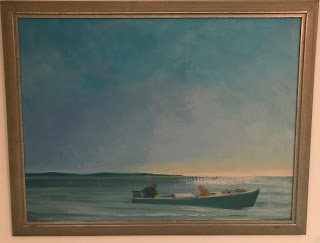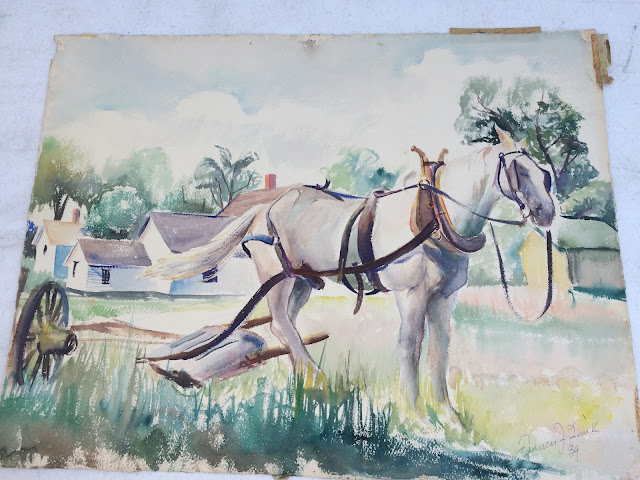Through Pennsylvania friends of Francis Quirk, we have obtained another image of a Quirk painting for the exhibition discussed in an earlier (September 19, 2016 post.)
 |
| Clutch Plate Painting in Frame by Francis Quirk |
 |
| Clutch Plate Painting by Francis Quirk |
Quirk Participates in "Impossible Art" Exhibit in 1970 with Avinash Chandra, Lenore Laine, Sybil Wilson, and Anthony Tortona- Including Quirk's Paintings
Francis Quirk did travel in some impressive circles. In the February 13 1970 issue of Lafayette, the College's student paper an art exhibition/opening is mentioned in the Happenings section. As we began to research the artists Quirk brought to Lehigh in this exhibition, we became increasingly impressed with their collective vibrancy.
The "Impossible Art" exhibition at Lehigh University would include works by Avinash Chandra, Francis J. Quirk , Lorna Laine, Sybil Wilson and Anthony Tortona.
Avinash Chandra was a well known artist from India.
 |
| Avinash Chandra at his easel. |
 |
| Painting by Avinash Chandra |
Chandra is well profiled including a discussion of this particular work on the South Asian Diaspora Literature and Arts Archive
Artist Avinash Chandra was born in Simla,India,in 1931. As a child,Chandra knew he was born to paint and in 1947 he enrolled at the Delhi Polytechnic Art School. His father had wanted him to study Engineering and for six months Chandra's family were unaware he was studying art. However,excelling in his chosen field,Chandra graduated in 1951 with a first class degree. He then joined the staff,teaching fine art to undergraduates.
Chandra's formal artistic training taught him little about Indian art and more about the 'alien' art of Europe and the west. As a young painter,he began painting landscapes which were highly acclaimed. They expressed nostalgia for the trees and landscape of the Simla hills using vibrant colours. At twenty-one years old,Chandra was the youngest artist to be granted a solo exhibition by the progressive artist's movement,the 'Delhi Silpi Chakra'. One of his first paintings,'Trees',was bought by the then newly established Museum of Modern Art in Delhi,and was awarded first prize in the First National Exhibition of Indian Art at the Lalit Kala Akademi in 1955. However,after three successful exhibitions and relative fame,Chandra grew dissatisfied and felt limited by the artistic scope in Delhi. Yearning for artistic liberation,in 1956 Chandra and his then artist wife,Prem Lata (d. 1975),left Delhi and moved to the UK,following an art scholarship awarded to Lata to study at the Central School of Art in London.
Renting a flat in North London,Chandra made space to complete half-finished canvases he had brought from India. For two years,he worked alone,applying his early influences of Van Gogh and Soutine. He mastered the technique of oils and quietly observed the trends and themes of worldwide attitudes to art. Chandra's first exhibition in England was hosted by the Royal India,Pakistan and Ceylon Society and held at the Commonwealth Institute (then the Imperial Institute),London in 1957. The exhibition,although successful,left Chandra frustrated. He witnessed the same class of people attend his exhibition as those who had seen his work in Delhi - upper class colonial subjects with royal connections. Chandra felt far from liberated,and saw his initial arrival on the London art scene as being from one colonial environment straight into another.
In 1959,the same exhibition toured to Belfast where Chandra lived for a period of time. Here,his landscape watercolour paintings reflected the city as he saw it,full of churches,steeple and trees. As time passed,Chandra replaced the churches in the foreground of his canvases with circular shapes he called 'heads',and moved the churches to the background of the landscape. His Belfast art was different from the work of his first exhibition in London,mainly because it became increasingly colourful. He painted his landscapes in vivacious reds and blues with strong black outlines and the finished pieces began to thrill him.
The late 1950s was a turning point in Chandra's artistic development. It was at this time he desired to break away from what he felt were rigid teachings imposed on him in Delhi. He explored philosophy and searched for an artistic expression that was entirely his own,and not influenced by external teachings or interpretations. After a period of gestation,paintings and drawings 'began to flow like lava' from Chandra.
It was the sale of a Chandra painting entitled 'Sun',to the famous tenor Sir Peter Pears (1919-1986) in 1960 at the Molton Gallery in London,that ignited the future value and pace of success of Avinash Chandra's work. The 1960s brought Avinash Chandra great public success and critical acclaim. Almost every national newspaper and major art magazine wrote about him. In 1961,Chandra's paintings were exposed to the European art world and were featured at various galleries around Europe. In 1962,the BBC produced a television documentary entitled 'Art of Avinash Chandra' exposing the uniqueness of his work. His paintings were showcased at solo exhibitions at the Gulbenkian Museum of Oriental Art in Durham,and in Newcastle,York and Middlesbrough as well as in a national touring exhibition in the United States.
In 1965,Chandra became the first Indian British artist to be featured at the Tate Gallery,London,with their purchase of 'Hills of Gold'. In London,the art community described Chandra's work as 'refreshing','optimistic' and him as 'an artist of great ability'.
During the mid 1960s,Avinash Chandra undertook several corporate art commissions for coloured glass murals and became renowned for their magnitude and vibrancy. Among Chandra's commissions were a mosaic mural for the Indian High Commission in Lagos in 1962,the Pilkington Brothers new office building in St Helens,Lancashire,and a fibre glass mural for the new Indian Tea Centre in Oxford Street,London,in 1964.
In 1967 Chandra moved to New York following an award by the Fairfield Foundation Fellowship for Travel and Study. He held several exhibitions on the East coast and was well received by the American art community. Chandra returned to London in 1973 and married actress Valerie Murray in 1977.
The so-called erotic imagery of Chandra's 1970s work has led many critics to draw a direct line between his work and Khajuraho,(the intricate sculptures of Hindu gods,girls dancing and lovers,proclaiming the most exalted experiences of men and women upon the temple walls). However,Chandra saw this connection as part of the preconceived perceptions of how India is seen by the West.
At this time,Avinash Chandra's main theme was the female body. He began with elegant line drawings which evolved throughout the 1970s,to subtle,erotic coloured drawings. Art critic Ronald Alley said of these paintings 'In Chandra's work,sexual images play a vital role,but it is important to realise that they are almost always introduced as part of a much larger experience in a wider context...their appeal Iies in their constant blending with other poetic images: spires,trees,flowers,hills,moons and stars.'
Avinash Chandra continued to work within this theme until the mid 1980s,when his paintings gradually returned to landscapes and nature.
 |
| Lenore Laine Painting "Cadrans bleus dans boîtes rouges" from the Musee de L'Oise in Beauvais France. Photo (C) RMN-Grand Palais / Thierry Ollivier |
 |
| Lenore Laine Portrait |
 |
| Painting by Lenore Laine |
Sybil Wilson went on to become known as a designer more than an artist. We found this bio and image on Polyvore.com
Sybil Wilson was born in Tulsa, Oklahoma in 1923. She studied at the Art Students League in New York with Ernest Fiene and, after having worked as a graphic designer in Connecticut, studied at Yale University with Josef Albers, receiving a BFA in 1954 and an MFA in 1959. Wilson also studied weaving privately with Anni Albers, and worked with her as editor on Anni Albers's 1961 book "On Designing." Wilson taught at the Rhode Island School of Design and at the University of Bridgeport, and exhibited her work in the 1960s and early-1970s. She was awarded the American Institute of Graphic Arts "50 Best" award in 1960, and her work is in the collections of New York University, University of Kentucky, University of Massachusetts and University of Bridgeport. Sybil Wilson died in 1997.
 |
| Black and White ARTIST: Sybil Wilson YEAR: circa 1970 MATERIALS: Acrylic on canvas CONDITION: Very good DIMENSIONS: 35 x 45 inches. |
As to Anthony Tortona, we have not been able to track down information on him or his work.
Quirk's Contribution
At the September 2016 auction in Maine, several Quirk paintings from the exhibition came up for sale. While they are not exceptional paintings, they do illustrate his draftsmanship and willingness to pursuue a new direction for the exhibition. They also add another argument for the case for his versatility.
 |
| Francis Quirk Painting for Impossible Art Exhibition at Lehigh University |
 |
| Francis Quirk Painting for Impossible Art Exhibition at Lehigh University :"Pear, Ivory, Pine" |
 |
| Label for "Pear, Ivory, Pine" by Francis Quirk |
Francis Quirk Painting for Impossible Art Exhibition at Lehigh University






















